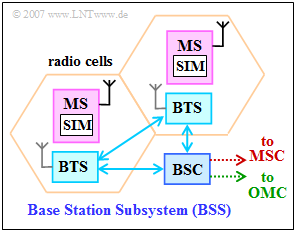Difference between revisions of "Exercise 3.1: GSM Network Components"
From LNTwww
| Line 3: | Line 3: | ||
}} | }} | ||
| − | [[File: | + | [[File:EN_Bei_A_3_1.png|right|frame|GSM: Base Station Subsystem]] |
The network infrastructure in the 2G mobile communications standard ''Global System for Mobile Communications'' - GSM for short - includes the following subsystems | The network infrastructure in the 2G mobile communications standard ''Global System for Mobile Communications'' - GSM for short - includes the following subsystems | ||
Revision as of 17:09, 3 January 2023
The network infrastructure in the 2G mobile communications standard Global System for Mobile Communications - GSM for short - includes the following subsystems
- Base Station Subsystem ('BSS),
- Switching & Management Subsystem ('SMSS),
- Operation & Maintenance Subsystem ('OMSS).
The "BSS" is essentially responsible for the GSM radio network (see diagram), while "SMSS" represents the switching network and "OMSS" is responsible for operations and maintenance.
The following terms continue to be used in the questions for this exercise:
- Authentication Center (AUC),
- Base Station Controller (BSC),
- Base Transceiver Station (BTS),
- Gateway Mobile Switching Center (GMSC),
- Home Location Register (HLR),
- Mobile Switching Center (MSC),
- Operation and Maintenance Center (OMC),
- Visitor Location Register (VLR).
Hint:
- This exercise belongs to the chapter "General Description of GSM".
Questions
Solution
(1) Correct is the proposed solution 1:
- Each mobile station (MS) is in radio communication with a Base Transceiver Station (BTS).
- This is part of the Base Station Subsystem (BSS).
(2) Correct are the proposed solutions 1 and 3:
- In contrast, proposed solution 2 is incorrect: The BTS is not responsible for switching tasks, but this is the exercise of a Mobile Switching Center (MSC), which is a part of the Switching and Management Subsystem (SMSS).
(3) In GSM, the individual antennas usually cover $120^\circ$ sectors. This also means that a BTS can provide up to three radio channels.
(4) The correct proposed solution 3 is:
- Only the Operation and Management Center (OMC) is part of the OMSS.
- In contrast, MSC and GMSC are components of the mobile switching network (SMSS).
- With respect to the OMC, a further distinction is made between OMC-B (for BSS monitoring) and OMC-S (for SMSS monitoring).
(5) Correct are proposed solutions 1, 3 and 4:
- GMSC is a hardware unit responsible for switching between the fixed and mobile networks.
- The other three terms given describe databases of the SMSS.
- AUC is responsible for storing confidential data and keys.
- HLR is a central register for the entire Public Land Mobile Network (PLMN) for managing unencrypted subscriber data, subscribed services, and routing for calls of a mobile operator's own subscribers.
- In contrast, the visitor register (VLR) stores information about the current visitors of other operators who are in the current PLMN.
